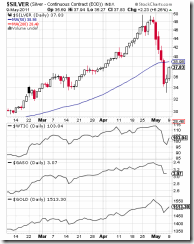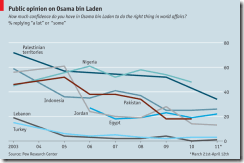Here is a terse video attacking Libertarianism which misleadingly uses Somalia as a "Libertarian's Paradise". (hat tip Bob Wenzel)
Why the video is short?
Because it deliberately applies the “cum hoc ergo propter hoc” or correlation is causation fallacy. The video's implication: Because Somalia has no government therefore she is poor PERIOD. By making it short the video eludes the required proofs. So this easily would dupe the ignorant.
Again, reference point matters.
I would like to say that Somalia IS NO LIBERTARIAN UTOPIA. But we certainly can learn some lessons from her experiences.
Yet it is very important to point out that even before Somalia overthrew her government she has already been poor. So it would be wrong to adduce poverty to statelessness.
And the reason for the impoverished state is that Somalia had been ruled by a nasty communist regime; the Somali Democratic Party (1969-1991). So essentially Somalia has swung from the extremes of total government to statelessness.
So the appropriate question is “has Somalia been better off at her current state or with the communists?”
The obvious answer is that Somalis said NO to communism.
Here is a briefer of Somalia from Wikipedia,
Somalia, from 1991 to 2006, is cited as a real-world example of a stateless society and legal system. Since the fall of Siad Barre's government in January 1991, there had been no permanent national government in Somalia until the current Transitional Federal Government. Large areas of the country such as Puntland, and Galmudug are internationally unrecognized autonomous regions, while Somaliland is a de facto sovereign state. The remaining areas, including the capital Mogadishu, were divided into smaller territories ruled by competing warlords. In many areas there were (and still are) no formal regulations or licensing requirements for businesses and individuals.
One would ask, if Somalis has been better off why the civil wars?
Again the Wikipedia,
With worsening conditions in Somalia, rebels of the United Somali Congress (USC) led by Mohamed Farrah Aidid attacked Mogadishu and on January 26, 1991, Barre's government was taken out of power.
In May 1991, the northernwestern Somaliland region of Somalia declared its independence. This Isaaq-dominated governing zone is not recognized by any major international organization or country, although it has remained more stable and certainly more peaceful than the rest of Somalia, neighboring Puntland notwithstanding.
UN Security Council Resolution 794 was unanimously passed on December 3, 1992, which approved a coalition of United Nations peacekeepers led by the United States to form UNITAF, tasked with ensuring humanitarian aid being distributed and peace being established in Somalia until the humanitarian efforts were transferred to the UN. The UN humanitarian troops landed in 1993 and started a two-year effort (primarily in the south), known as UNOSOM II, to alleviate famine conditions.
Many Somalis opposed the foreign presence. In October, several gun battles in Mogadishu between local gunmen and peacekeepers resulted in the death of 24 Pakistanis and 19 US soldiers (total US deaths were 31). Most of the Americans were killed in the Battle of Mogadishu. The incident later became the basis for the book and movie Black Hawk Down. The UN withdrew on March 3, 1995, having suffered more significant casualties. Order in Somalia still has not been restored.
Yet again another secession from Somalia took place in the northeastern region. The self-proclaimed state took the name Puntland after declaring "temporary" independence in 1998, with the intention that it would participate in any Somali reconciliation to form a new central government.
A third secession occurred in 1998 with the declaration of the state of Jubaland. The territory of Jubaland is now encompassed by the state of Southwestern Somalia and its status is unclear.
A fourth self-proclaimed entity led by the Rahanweyn Resistance Army (RRA) was set up in 1999, along the lines of the Puntland. That "temporary" secession was reasserted in 2002. This led to the autonomy of Southwestern Somalia. The RRA had originally set up an autonomous administration over the Bay and Bakool regions of south and central Somalia in 1999.
So we have a combination of foreign meddling and competing tribes. We might say that foreign meddling to impose a national government may have been a significant factor in creating tribal frictions.
We see such relevance in the repeated foreign incursions on Somalia’s fishing grounds which partly depleted local fisherman’s livelihood that has spawned famously notorious Pirate Industry which I earlier wrote about.
How about today?
Again the Wikipedia, (bold highlights mine)
The various Somali militias had at that point developed into security agencies for hire. Due to that development, security had much improved and an economic rebound occurred. Somalia was then arguably partly in a state of anarcho-capitalism, where all services were provided by private ventures. According to the CIA, Somalia's telecommunication firms provide wireless services in most major cities and offer the lowest international call rates on the continent.
In 2000, Abdiqasim Salad Hassan was selected to lead the Transitional National Government (TNG).
This was followed in 2004 by the establishment of the Transitional Federal Government (TFG) of the Republic of Somalia, the most recent attempt to restore national institutions to the nation after the 1991 collapse of the Barre regime and the ensuing civil war. On October 10, 2004, Somali parliament members elected Abdullahi Yusuf Ahmed, the former President of Puntland, to be the next president and head of the TFG. The other institutions adopted at this time were the Transitional Federal Charter and the selection of a 275-member Transitional Federal Parliament.
Though internationally recognized, the TFG's support in Somalia was waning until the United States-backed 2006 intervention by the Ethiopian military, which helped drive out the rival Islamic Courts Union (ICU) in Mogadishu and solidify the TFG's rule. Following this defeat, the ICU splintered into several different factions. Some of the more radical elements, including Al-Shabaab, regrouped to continue their insurgency against the TFG and oppose the Ethiopian military's presence in Somalia. Throughout 2007 and 2008, Al-Shabaab scored military victories, seizing control of key towns and ports in both central and southern Somalia. At the end of 2008, the group had captured Baidoa but not Mogadishu. By January 2009, Al-Shabaab and other militias had managed to force the Ethiopian troops to withdraw from the country, leaving behind an underequipped African Union (AU) peacekeeping force.
Over the next few months, a new President was elected from amongst the more moderate Islamists, and the Transitional Federal Government, with the help of a small team of African Union troops, began a counteroffensive in February 2009 to retake control of the southern half of the country. To solidify its control of southern Somalia, the TFG formed an alliance with the Islamic Courts Union and other members of the Alliance for the Re-liberation of Somalia. Furthermore, Al-Shabaab and Hizbul Islam, the two main Islamist groups in opposition, began to fight amongst themselves in mid 2009.
As a truce, in March 2009, Somalia's newly established coalition government announced that it would implement shari'a as the nation's official judicial system.
As one would note, there has been so many and continuous foreign meddling in Somalia in the attempt to foist a national government, on what seems to be a society averse to government.
As Professor Ben Powell writes, (bold highlights mine)
The Somalis again have united against this attempt by outsiders to force a government on them. Unfortunately, the result has been an increase in the power of the Union of Islamic Courts (UIC), who, since June, has gained control over much of southern Somalia, including the former capital, Mogadishu. An estimated 600 militias have joined the UIC since the TFG moved into Baidoa in February.
Every government of Somalia has exploited the country’s population. International meddling created the TFG and, unintentionally, a more powerful UIC. If either group were to become a true government, the population likely will once again become oppressed. In the meantime, the two groups appear headed back into civil war, which will likely result in the kind of chaos the country has not experienced since 1995.
Prime Minister Gedi of the TFG recently said, “It is totally misguided not to accept the government. The alternative is chaos.” Unfortunately, he’s got it exactly backwards. It is, in fact, the attempts to impose a government on Somalia that create chaos.
Aside from the wireless services which offers the “lowest international call rates on the continent” as cited by above by Wikipedia, the current economy of the 9.1 m population of Somalia, again as tersely described by Wikipedia, (bold emphasis mine)
Although it states that no reliable statistics are available for the period in question, the United Nations claims that Somalia, already one of the poorest countries in the world, has become even poorer as a result of civil war. However, the CIA Factbook maintains that gains were made during the early 2000s; "despite the seeming anarchy, Somalia's service sector has managed to survive and grow. Mogadishu's main market offers a variety of goods from food to the newest electronic gadgets. Hotels continue to operate, and militias provide security."
When extreme poverty (percentage of individuals living on less than PPP$1 a day) was last measured by the World Bank in 1998, Somalia fared better than many other countries in Africa, over some of whom Somalia also had superior infrastructure. The CIA World Factbook counsels that "Statistics on Somalia's GDP, growth, per capita income, and inflation should be viewed skeptically", while estimating Somalia's GDP per capita at $600.
In the absence of a Somali state and its institutions, the private sector grew "impressively" according to the World Bank in 2003, particularly in the areas of trade, commerce, transport, remittance and infrastructure services and in the primary sectors, notably in livestock, agriculture and fisheries. In 2007, the United Nations reported that the country's service industry is also thriving. Economist Peter T. Leeson, in an event study of "the impact of anarchy on Somali development", found that "[t]he data suggest that while the state of this development remains low, on nearly all of 18 key indicators that allow pre- and post-stateless welfare comparisons, Somalis are better off under anarchy than they were under government." Powell et al. concur that in absolute terms, Somalia’s living standards have improved and compare favorably with many existing African states, but also report that living standards have often improved "relative to other African countries since the collapse of the Somali central government."
It would be a nightmare for governments and politicians around the world to see a stateless society succeed. So the intuitive response is to view data from a stateless government “sceptically”.
Just imagine if Somalia should succeed then there could be mass revolutions to overthrow governments around the world. That's something governments won't want to happen.
So obviously there will always be a reason to keep Somalia poor.
And this video is part of such propaganda.









